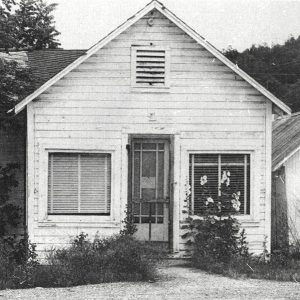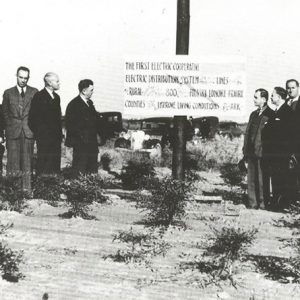calsfoundation@cals.org
Rural Electrification
The first major effort to provide electricity to rural Arkansas began with the passage of the federal Rural Electrification Act in 1936, creating the Rural Electrification Administration (REA). The agency was one of President Franklin D. Roosevelt’s New Deal programs to improve the economic condition of farmers hit hard by depression, flood, and drought. It provided twenty-five-year loans at three percent interest for constructing power lines in rural areas. With REA loans, farmers could afford to electrify their homes and farms. Electrified farms, officials believed, would improve farm incomes and raise farm standards of living.
Providing electricity to Arkansas farms and communities of fewer than 2,500 people was costly. Rural areas averaged fewer than five customers per mile of electric line, compared with an average of fifteen to twenty per mile in urban areas. To recoup the costs of building a line, and to make a profit, private utilities charged rural customers more per kilowatt hour than they charged urban residents. Because of the high rates, farmers used an average of forty kilowatt hours a month, while urban residents typically used at least 500. Low use by rural customers made it less profitable for private utility companies to serve them.
Before the Rural Electrification Administration, rural electric service was limited. In 1930, 2.1 percent of Arkansas farms had electricity. Most received it from central power stations such as those operated by Arkansas Power and Light (AP&L) or one of the state’s four other public utilities. Harvey Couch, Arkansas Power & Light president, understood that electrifying farms could raise farm incomes. AP&L had electrified the rice fields around Stuttgart (Arkansas County) by 1918. In 1935, Couch initiated a private-utility rural electrification program by building lines to Prattsville (Grant County) and Malvern (Hot Spring County). To encourage electricity use, AP&L was the first private utility in the country to offer a low-cost financing plan to wire rural homes and a monthly payment plan for buying appliances. The Rural Electrification Administration later adopted Couch’s financing plan, calling it the “Arkansas Plan.”
The federal government’s first experiment with rural electrification was the Tennessee Valley Authority (TVA), which began providing inexpensive electricity to rural residents of the Tennessee River valley in 1934. Through TVA, farmers throughout the South could see firsthand the benefits of using electricity to grind corn, milk cows, and perform other chores. Farm wives saw the benefits of electric water pumps, washing machines, irons, lights, and radios. TVA spurred increased demand in rural areas for inexpensive electricity.
The Rural Electrification Administration was created to meet that demand. To qualify for an REA loan, farm and community leaders had to organize an electric cooperative. In Arkansas, three electric cooperatives were incorporated by June 1937: First Electric Cooperative, serving parts of Lonoke, Prairie, and Pulaski counties; Woodruff Electric Cooperative, serving parts of Woodruff County; and Farmers Electric Cooperative, serving parts of Jackson County. Four more cooperatives were incorporated later in 1937. First Electric energized an initial fifty-eight miles of line on April 15, 1938, after borrowing $190,000 from the REA to build 211 miles of line to serve 675 members. All seven of the 1937 cooperatives energized lines the next year. The last cooperative, Rich Mountain, was incorporated in 1945, for a total of eighteen cooperatives. By 1950, sixty-seven percent of the state’s farms had been electrified.
The rural electrification program had important state government and farm association sponsors. In 1937, Governor Carl E. Bailey signed into law Act 342 of the legislature to provide a legal basis for electric cooperatives to incorporate. Bailey also appointed Department of Public Utilities commissioners who were sympathetic to the rural electrification program. The department issued rulings that set an affordable wholesale rate for the cooperatives, opening the way for REA approval of loans to Arkansas cooperatives.
Garfield (Benton County) native Clyde Taylor Ellis was a member of the U.S. House of Representatives and a pioneer in the nation’s rural electrification movement, serving as the first general manager of the National Rural Electric Cooperative Association (NRECA), which was formed to help promote and protect the interests of the rural electrification program
The Arkansas Farm Bureau Federation supported the rural electrification program by sponsoring REA cooperatives and putting local farm leaders in touch with the electrification agency. County extension agents from the University of Arkansas Cooperative Extension Service (UACES) organized farmers, signed members to the co-ops, and reviewed the cooperatives’ plans for electrical lines.
The success of the Tennessee Valley Authority and the problem of negotiating affordable wholesale rates gave rise to discussions of forming an Arkansas Valley Authority. It never became a reality, but hydroelectric dams were constructed along the White and Ouachita rivers that provide affordable electricity to the cooperatives.
Today, seventeen electric cooperatives operate in Arkansas. These cooperatives, in turn, own—and are members of—two statewide cooperatives: Electric Cooperatives of Arkansas, which represents the cooperatives’ interests at the state level, and the Arkansas Electric Cooperative Corporation, which supplies wholesale electricity to the cooperatives.
Rural electrification fulfilled the promise of improving farm standards of living. Besides other benefits, the electrification of farms led to the growth of Arkansas’s poultry industry.
For additional information:
Electric Cooperatives of Arkansas. http://www.aeci.com/ (accessed May 5, 2025).
Brown, D. Clayton. Electricity for Rural America: The Fight for the REA. Westport, CT: Greenwood Press, 1980.
———. “Hen Eggs to Kilowatts: Arkansas Rural Electrification.” Red River Valley Historical Review 3 (Winter 1978): 119–126.
Mary Suter
University of Arkansas Museum Collections
 First Electric Co-op Building
First Electric Co-op Building  First Electric Cooperative's First Power Pole
First Electric Cooperative's First Power Pole  Ozark REA Plant
Ozark REA Plant 



Comments
No comments on this entry yet.